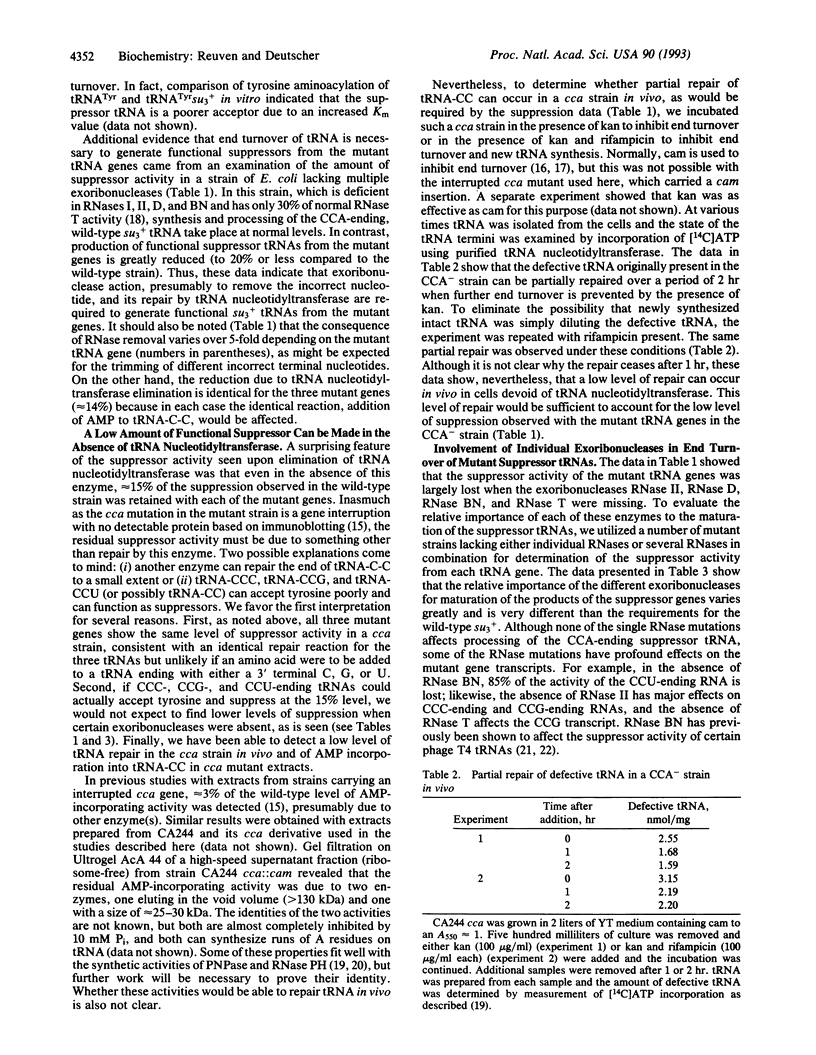Abstract
We have altered by site-directed mutagenesis the 3' terminal adenosine residue of a tRNA(Tyrsu3+) gene encoded on a single-copy plasmid and examined the consequences of these substitutions on suppressor activity in vivo. Our data show that mutant su3 genes containing 3'-CCC, -CCG, or -CCU termini instead of -CCA can be efficiently transcribed and processed in Escherichia coli to generate functional suppressor tRNAs. However, in contrast to normal tRNA genes, both tRNA nucleotidyltransferase and exoribonuclease activities are required to obtain suppression by the mutant tRNAs, indicating that removal of the incorrect 3' terminal residue and resynthesis of the normal -CCA terminus are occurring in this situation. In addition, a low level of suppressor activity and tRNA repair was found in cells devoid of tRNA nucleotidyltransferase, suggesting that an additional activity able to partially repair the 3' end of tRNA is present in E. coli. The use of mutant strains lacking one or several exoribonucleases revealed that the various RNAses have very different specificities for removal of incorrect 3' residues and that these differ greatly from their action on CCA-ending tRNA. These data show that the 3' terminal adenosine residue is necessary for tRNA function in vivo and that cells can compensate for its alteration by changes in the normal pathway of tRNA metabolism.
Full text
PDF



Selected References
These references are in PubMed. This may not be the complete list of references from this article.
- Cudny H., Deutscher M. P. High-level overexpression, rapid purification, and properties of Escherichia coli tRNA nucleotidyltransferase. J Biol Chem. 1986 May 15;261(14):6450–6453. [PubMed] [Google Scholar]
- Deutscher M. P., Lin J. J., Evans J. A. Transfer RNA metabolism in Escherichia coli cells deficient in tRNA nucleotidyltransferase. J Mol Biol. 1977 Dec 25;117(4):1081–1094. doi: 10.1016/s0022-2836(77)80014-4. [DOI] [PubMed] [Google Scholar]
- Deutscher M. P., Marlor C. W., Zaniewski R. RNase T is responsible for the end-turnover of tRNA in Escherichia coli. Proc Natl Acad Sci U S A. 1985 Oct;82(19):6427–6430. doi: 10.1073/pnas.82.19.6427. [DOI] [PMC free article] [PubMed] [Google Scholar]
- Deutscher M. P. Ribonucleases, tRNA nucleotidyltransferase, and the 3' processing of tRNA. Prog Nucleic Acid Res Mol Biol. 1990;39:209–240. doi: 10.1016/s0079-6603(08)60628-5. [DOI] [PubMed] [Google Scholar]
- Deutscher M. P. Synthesis and functions of the -C-C-A terminus of transfer RNA. Prog Nucleic Acid Res Mol Biol. 1973;13:51–92. doi: 10.1016/s0079-6603(08)60100-2. [DOI] [PubMed] [Google Scholar]
- Foulds J., Hilderman R. H., Deutscher M. P. Mapping of the locus for Escherichia coli transfer ribonucleic acid nucleotidyltransferase. J Bacteriol. 1974 May;118(2):628–632. doi: 10.1128/jb.118.2.628-632.1974. [DOI] [PMC free article] [PubMed] [Google Scholar]
- Kelly K. O., Reuven N. B., Li Z., Deutscher M. P. RNase PH is essential for tRNA processing and viability in RNase-deficient Escherichia coli cells. J Biol Chem. 1992 Aug 15;267(23):16015–16018. [PubMed] [Google Scholar]
- Komine Y., Adachi T., Inokuchi H., Ozeki H. Genomic organization and physical mapping of the transfer RNA genes in Escherichia coli K12. J Mol Biol. 1990 Apr 20;212(4):579–598. doi: 10.1016/0022-2836(90)90224-A. [DOI] [PubMed] [Google Scholar]
- Kunkel T. A., Roberts J. D., Zakour R. A. Rapid and efficient site-specific mutagenesis without phenotypic selection. Methods Enzymol. 1987;154:367–382. doi: 10.1016/0076-6879(87)54085-x. [DOI] [PubMed] [Google Scholar]
- Larsen J. E., Gerdes K., Light J., Molin S. Low-copy-number plasmid-cloning vectors amplifiable by derepression of an inserted foreign promoter. Gene. 1984 Apr;28(1):45–54. doi: 10.1016/0378-1119(84)90086-6. [DOI] [PubMed] [Google Scholar]
- Maisurian A. N., Buyanovskaya E. A. Isolation of an Escherichia coli strain restricting bacteriophage suppressor. Mol Gen Genet. 1973 Feb 2;120(3):227–229. doi: 10.1007/BF00267154. [DOI] [PubMed] [Google Scholar]
- Mazzara G. P., McClain W. H. Cysteine transfer RNA of Escherichia coli: nucleotide sequence and unusual metabolic properties of the 3' C-C-A terminus. J Mol Biol. 1977 Dec 25;117(4):1061–1079. doi: 10.1016/s0022-2836(77)80013-2. [DOI] [PubMed] [Google Scholar]
- Moazed D., Noller H. F. Sites of interaction of the CCA end of peptidyl-tRNA with 23S rRNA. Proc Natl Acad Sci U S A. 1991 May 1;88(9):3725–3728. doi: 10.1073/pnas.88.9.3725. [DOI] [PMC free article] [PubMed] [Google Scholar]
- Ost K. A., Deutscher M. P. RNase PH catalyzes a synthetic reaction, the addition of nucleotides to the 3' end of RNA. Biochimie. 1990 Nov;72(11):813–818. doi: 10.1016/0300-9084(90)90190-r. [DOI] [PubMed] [Google Scholar]
- Reuven N. B., Deutscher M. P. Multiple exoribonucleases are required for the 3' processing of Escherichia coli tRNA precursors in vivo. FASEB J. 1993 Jan;7(1):143–148. doi: 10.1096/fasebj.7.1.8422961. [DOI] [PubMed] [Google Scholar]
- Seidman J. G., Schmidt F. J., Foss K., McClain W. H. A mutant of escherichia coli defective in removing 3' terminal nucleotides from some transfer RNA precursor molecules. Cell. 1975 Aug;5(4):389–400. doi: 10.1016/0092-8674(75)90058-6. [DOI] [PubMed] [Google Scholar]
- Sprinzl M., Cramer F. The -C-C-A end of tRNA and its role in protein biosynthesis. Prog Nucleic Acid Res Mol Biol. 1979;22:1–69. doi: 10.1016/s0079-6603(08)60798-9. [DOI] [PubMed] [Google Scholar]
- Zhu L., Deutscher M. P. tRNA nucleotidyltransferase is not essential for Escherichia coli viability. EMBO J. 1987 Aug;6(8):2473–2477. doi: 10.1002/j.1460-2075.1987.tb02528.x. [DOI] [PMC free article] [PubMed] [Google Scholar]


